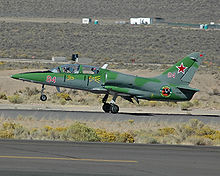The Aero L-39 Albatros is a high-performance jet trainer aircraft developed in Czechoslovakia to meet requirements for a "C-39" (C for cvičný – trainer) during the 1960s to replace the L-29 Delfín. It was the first of the second-generation jet trainers, and the first turbofan-powered trainer produced, and was later updated as the L-59 Super Albatros and as the L-139 (prototype L-39 with engine Garrett TFE731). The design is still produced in an evolved state as the L-159 ALCA, more than 2,800 L-39s have served with over 30 air forces around the world. The Albatros – the most widely used jet trainer in the world – is versatile, seeing duty in light-attack missions as well as in basic and advanced pilot training.
| L-39 Albatros | |
|---|---|
| L-39C, Jet Class, Reno National Championship Air Races #58 | |
| Role | Military trainer aircraft Light ground-attack aircraft |
| Manufacturer | Aero Vodochody |
| First flight | 4 November 1968 |
| Introduction | 1971 |
| Status | 2,800 still in use in various air forces |
| Primary users | Soviet Air Force Czechoslovak Air Force Libyan Air Force Royal Thai Air Force Lithuanian Air Force |
| Produced | 1970s-1999 |
| Unit cost | US$200,000-300,000 |
| Developed from | Aero L-29 Delfín |
| Variants | Aero L-59 Super Albatros Aero L-159 Alca |
Design and development
The L-39 (under the name Prototype X-02) first flew on 4 November 1969 and was piloted by Rudolf Duchoň, the factory's test pilot. Serial production began in 1971. The design is Czechoslovak (Czech) – the construction of Aero's chief designer Jan Vlček. The L-39 Albatros is a widely flown trainer/light attack aircraft similar in mission to the Italian MB339. Until now is in service with various former Soviet allies.The low, slightly swept wing has a double-taper planform, 2½-deg dihedral from the roots, a relatively low aspect ratio, and 100 liter (26½ gal US) fuel tanks permanently attached to the wingtips .[citation needed] The trailing edge has double-slotted trailing edge flaps inboard of mass-balanced ailerons; the flaps are separated from the ailerons by small wing fences.
The tall, swept vertical tail has an inset rudder. Variable-incidence horizontal stabilizers with inset elevators are mounted at the base of the rudder and over the exhaust nozzle. Side-by-side airbrakes are located under the fuselage ahead of the wing's leading edge. Flaps, landing gear, wheel brakes and air brakes are powered by a hydraulic system. Controls are pushrod-actuated and have electrically powered servo tabs on the ailerons and rudder. Operational g-force limits at 4,200 kg (9,259 lb) are +8/-4 g.
A single turbofan engine, an Ivchenko AI-25TL (made in the Soviet Union) is embedded in the fuselage and is fed through shoulder-mounted, semi-circular air intakes (fitted with splitter plates) just behind the cockpit; the engine exhausts below the tailplane. Five rubber bag fuel tanks are located in the fuselage behind the cockpit. The main, trailing-arm landing gear legs retract inward into wing bays; the nose gear retracts forward.
A long, pointed nose made of aluminum leads back to the tandem cockpit, in which the student and instructor sit under individual canopies that are hinged on the right. The rear (instructor's) seat is raised slightly; both ejection seats are made by Aero.
The basic trainer is not armed, but has two underwing pylons for drop tanks and practice weapons. Light-attack variants have four underwing hardpoints for ground attack stores; the ZA also has an underfuselage gun pod.
This model is no longer in production and is replaced by the L-159.
Operational history
| This section requires expansion. |
Abkhazia
In the spring of 2008, a number of Georgian drones were shot down by Abkhaz separatist or Russian forces. In the first of these occasions, on April 20, 2008. Another was shot down by a Russian MiG-29 over Abkhazia region. The Abkhazian separatist forces claimed that one of its missile-equipped L-39's had downed a Georgian Hermes 450 unmanned reconnaissance drone. [3]Nagorno-Karabakh War
L-39s, along with older L-29s,were used extensively in ground attack missions in the Nagorno-Karabakh War by Azeri forces. Several were shot down by Armenian air-defences.[1]Popular warbird
While newer versions are now replacing older L-39s in service, thousands remain in active service as trainers, and many are finding new homes with private owners all over the world. This is particularly evident in the United States, where their $200,000-$300,000 price puts them in range of moderately wealthy pilots looking for a fast, agile personal jet. Their popularity led to a purely L-39 Jet class at the Reno Air Races (though it has since been expanded to include other, similar aircraft). As of mid-March 2006, there are 257 L-39s in the US Federal Aviation register. The first legally registered L-39 private aircraft was successfully flown on a cross country ferry flight in the US on December 9, 1992 with Pilot D. McCue and observer J. Yurick.Several display teams use the L-39 such as The Patriots Jet Team (6 L-39s) and the Breitling Jet Team (7 L-39s).
There are also several L-39 available for private jet rides: In the United States: in Florida, New York and California, in Australia,http://sydneyjetfighter.com/, http://aircombat.com.au/, http://www.jetride.com.au/, Czech Republic, Germany, France, and Spain.[2] Those L-39 jets are mostly in private hands. But they can also belong to training facilities of the Ministry of Defense, this is the case in Vyazma, Russia.[3]
In popular culture
An L-39 was used in the James Bond film, Tomorrow Never Dies, where the James Bond character steals the aircraft. In the arms deal scene in the beginning of the film, 007 takes the plane to get away from the terrorists. The plane is not mentioned by name but it is clearly an L-39. The 2005 film Lord of War features a scene in which an L-39 intercepts an An-12 cargo plane.[4]It is also featured prominently in ARMA 2: Operation Arrowhead as a fighter for the Takistani Airforce.
Several L39's were used extensively in the 2010 movie Kill Speed. [5]
Variants
- L-39X-01 - X-07
- Five prototypes plus two static test airframes.[6]
- L-39C (C for Cvičná - training)
- Standard basic trainer for Soviet Union, Czechoslovakia and export. Originally designated L-39, but renamed L-39C when later variants appeared. Two pylons under wing. Approximately 2,260 built.[7]
- L-39CM (CM for Cvičná modernizovaná - modernised training)
- Slovak upgraded C version.
- L-39M1[8]
- Ukrainian upgraded C version with AI-25TLSh engines. The conversion is carried out by Odesaviaremservis and the first plane was ready in 2009. The upgrade of a further 7 L-39C's is planned.[9]
- L-39V (V for Vlečná - tug)
- Single-seat target tug version for Czechoslovakia. Equipped to tow KT-04 target on 1,700 m (5,600 ft) cable. Prototype plus eight production aircraft built.[10]
- L-39ZO (Z for Zbraně - weapons)
- Interim weapon trainer variant for export. Four pylons stressed for 500 kg (1,100 lb) (inboard) and 250 kg (550 lb) (outboard), with total external load of 1,150 kg (2,500 lb).[11] First flew 25 June 1975, with initial deliveries to Iraq in 1977. 337 built.[12]
- L-39ZA
- Significantly upgraded L-39ZO for armed training and light attack, employing sturdier landing gear, a higher payload (total 1,290 kg (2,844 lb))[11] and notably provision for a GSh-23L 23 millimeter twin barreled cannon attached in a conformal pod under the pilots' compartment, having a 150 round magazine within the airframe. Outer pylons wired to carry K-13 or R-60 air-to-air missiles. Two prototypes, with first flying on 29 September 1976. 208 aircraft delivered.[13]
- L-39ZAM
- Slovak upgraded ZA version.
- L-39ZA/ART
- Thai version of L-39ZA with Elbit avionics. 40 built.[14]
- L-39MS
- The Aero L-39MS Super Albatros is a second generation military trainer aircraft developed from the firm's earlier L-39. Compared to its predecessor, it featured a strengthened fuselage, longer nose, a vastly updated cockpit, and a more powerful (21.6 kN (4,850 lbf)) Lotarev DV-2 engine, allowing operation at higher weights and speeds (max speed 872 km/h (542 mph)).[15] First flight on 30 September 1986. It was later designated as the Aero L-59 .[16]
- L-139 Albatros 2000
- Revised version with western avionics and 17.99 kN (4,045 lbf) Garrett TFE731-4-1T engine. Single prototype built.[17]
- L-159
- Further modernised advanced trainer/combat aircraft with more modern, western avionics and Honeywell F124 engine.[18]
Operators
|
|













0 Comment:
Posting Komentar